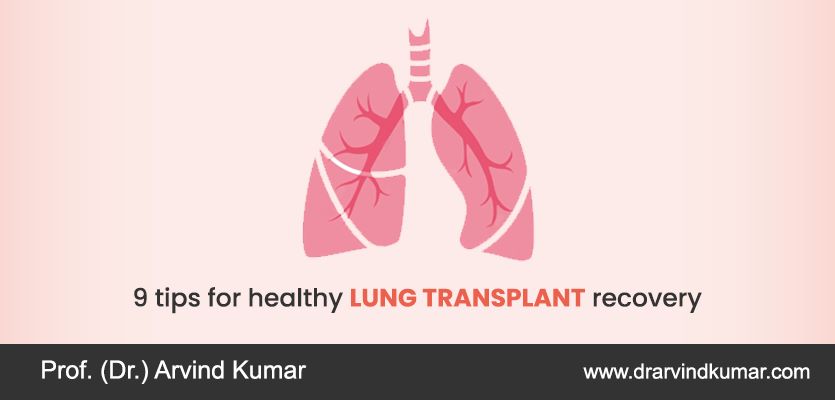We dont frequently think about how important our lungs are in keeping us healthy and strong in our day-to-day lives. We only realize how hard our lungs work for us when we are having breathing difficulties. The fact is that for our lungs to perform at their peak, everyday care and attention are necessary, just like for the rest of our body.
Your bodys cells receive oxygen by breathing. People are more susceptible to health issues when there is not enough oxygen being supplied to the cells. Some problems are respiratory illnesses, chronic obstructive pulmonary disease, and even heart disease, all illnesses which might eventually necessitate a Lung Transplant– a surgical procedure that is performed to treat Lung failure.
Due to damaged or diseased lungs, the blood is not purified and is not oxygenated. As a result deoxygenated blood is pumped into the organs which can cause multiple organ failures. Lung damage can be caused due to various factors. People with acute Lung failure usually opt for medication but in the case of chronic Lung failure, Lung Transplant is the only option.
Recovery After Lung Transplant
Healthy recovery after lung transplant, of lung transplant candidates, plays a crucial role in enhancing physical function before transplant and enabling optimal function recovery after transplant.
As medical and surgical lung transplantation procedures have progressed over time a change in the demographics of patients having lung transplantation has occurred. These patients now include elderly people, people with many comorbidities, and candidates who have respiratory failure and need to be bridged to transplantation. The demands of lung transplant candidates and recipients in terms of rehabilitation are impacted by these developments. How To Stay Healthy After Lung Transplant?
Lung Transplant After Care
It is important for you to be in good shape before and after the procedure for a speedy and healthy lung transplant recovery. To achieve the objectives required for a successful lung transplant, it is crucial that you work with your rehabilitation therapists and the transplant team.
Recovery is a lot of work, but it pays off when you can resume a lot of the things you may have previously thought were just in your fantasies.
Lung transplant after care has many facets and requires that you learn some new skills and adjust to a new routine. Follow these nine tips to improve your lung health and to have a healthy lung transplant recovery:
Regular Follow-up Visits:
For the next three months after your surgery, you should visit for regular check-ups and monitoring as instructed by the transplant team. Keep all your appointments with your doctor and have regular follow-up visits after leaving the hospital. These visits are important as they include significant tests and exams which ensure a swift and healthy recovery after a lung transplant. Tests such as:
Medication:
Take all of your medications on time and exactly as prescribed. There are chances that your body may take a transplanted lung as a foreign body and attack it. To avoid such conditions, the doctor prescribes immunosuppressants for the rest of your life. It’s imperative that you do not skip, change or discontinue any of your medicines without consulting your doctor.
Avoid Crowds:
Due to immunosuppressants, you will be more susceptible to catching certain infections. These include oral yeast infection (thrush), herpes, and respiratory viruses. For the first few months after surgery, make sure to avoid crowds and anyone who has an infection. Do not hesitate to restrict visitors to your home while you are recovering.
Healthy Lifestyle:
Following a healthy lifestyle, practicing hygiene, no-smoking rules, staying hydrated, and adopting healthy eating habits must become a part of your daily routine after a lung transplant. Keep your home and work environments smoke-free. Don’t go near areas where there are fumes or smoke, and avoid areas where people are smoking.
Breathing Exercises:
Your ability to accomplish more and be more active should increase now that you have fresh lungs and breathing exercises will help you achieve that. Diaphragmatic breathing, pursed lips breathing, deep breathing, and breath count are a few exercises recommended to improve your lung health. However, you should only do this under the advisement of your doctor and your physical therapists
Physical Exercise:
Exercise training following lung transplantation shows significant increases in exercise capacity and muscle strength. But remember to start slowly and gradually increase your physical activities after your incision has healed. Do not lift anything heavy, and avoid strenuous physical work for at least six to eight weeks after surgery. It is important that you also not lift anything greater than 10 pounds after six months from the date of your surgery.
Eat Lung Healthy Food:
You should consume more lean meat, chicken, fish, and low-fat dairy items to encourage a healthy lung transplant recovery. You should consume a mix of cereals, fruits, and vegetables to receive enough calories, vitamins, and minerals – all the components of food for lung patient recovery.
Regular Sleep:
Many patients have difficulty sleeping for some time following surgery due to discomfort from healing, stress from personal worries, or adverse effects from drugs.
Try these suggestions if youre having trouble falling asleep: Set up a regular sleeping routine; go to bed and rise at around the same time each day. Dont take too many naps during the day. Avoid caffeine and play some soothing music.
Pulmonary rehabilitation:
You can also participate in pulmonary rehabilitation (PR) programs. These programs offer knowledge and exercise to assist you in controlling your breathing problems. Additionally, they improve your capacity for activity and can reduce breathlessness. PR entails a program that is tailored for you and consists of several sessions overseen by qualified experts. The exercises help you extend the length of time you can work out by beginning at a level you can tolerate.
FAQs
Based on a number of criteria the cost of a lung transplant in India ranges from 12,50,000 INR to 27,50,00 INR approx.
The single lung transplant cost in India is around 17,00,000 INR.
The double lung transplant cost in India is around 27,50,000 INR.
The combined heart and lung transplant cost in India is around 5,350,000 INR.
If you are experiencing any of these symptoms, contact your transplant coordinator immediately:
- Fever over 100°F (38°C)
- “Flu-like” symptoms: chills, aches, headache, dizziness, nausea, and/or vomiting
- Chest congestion
- Cough
- Shortness of breath
- New pain or tenderness around the lung
- Fatigue or generally feeling “lousy”

.webp)



